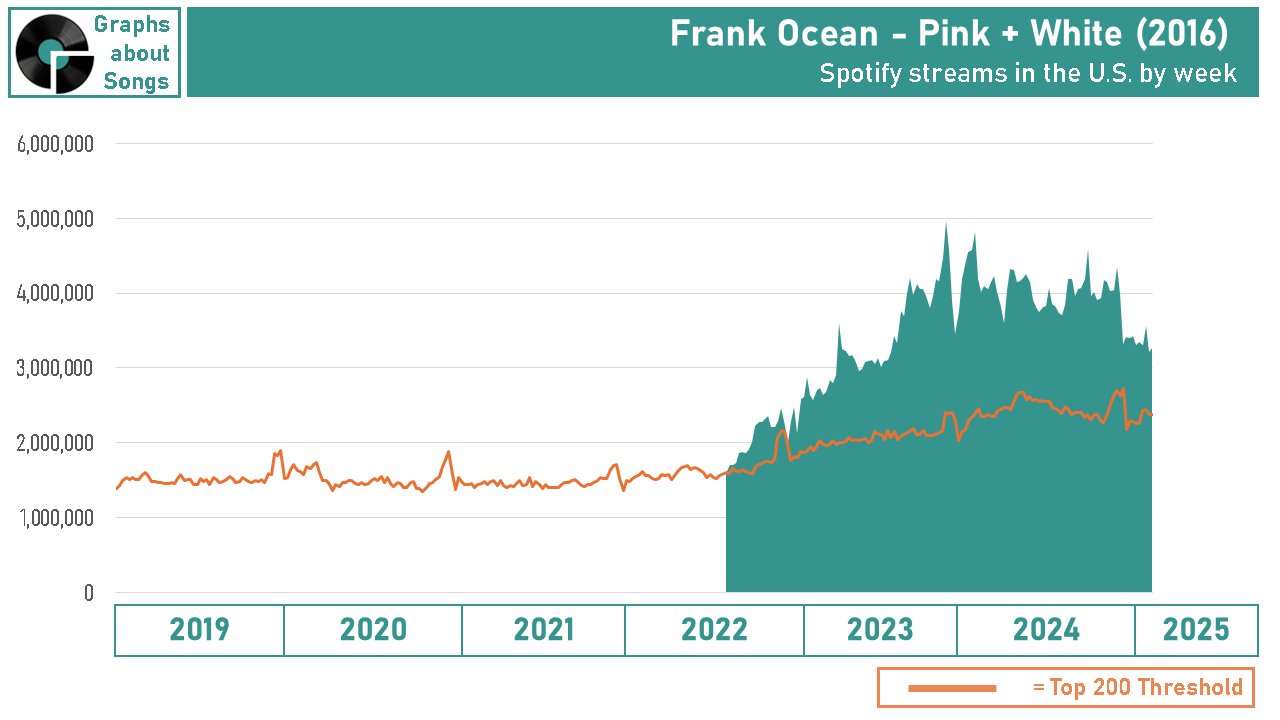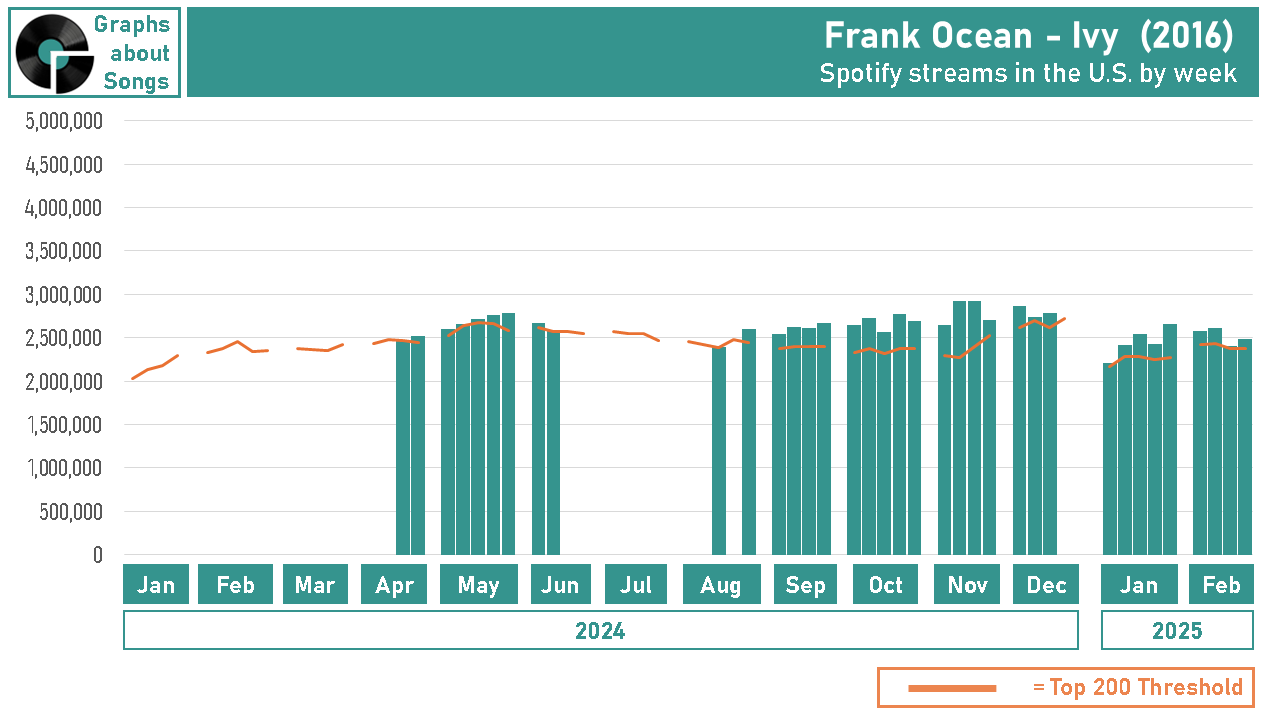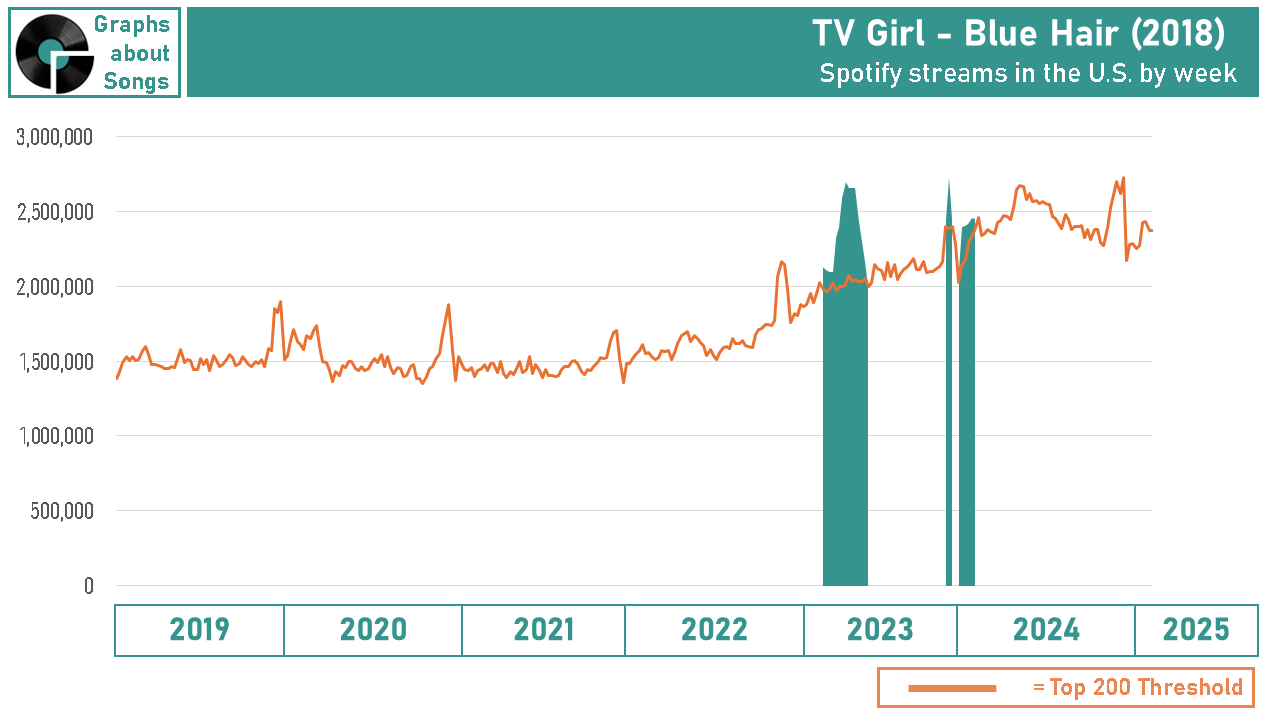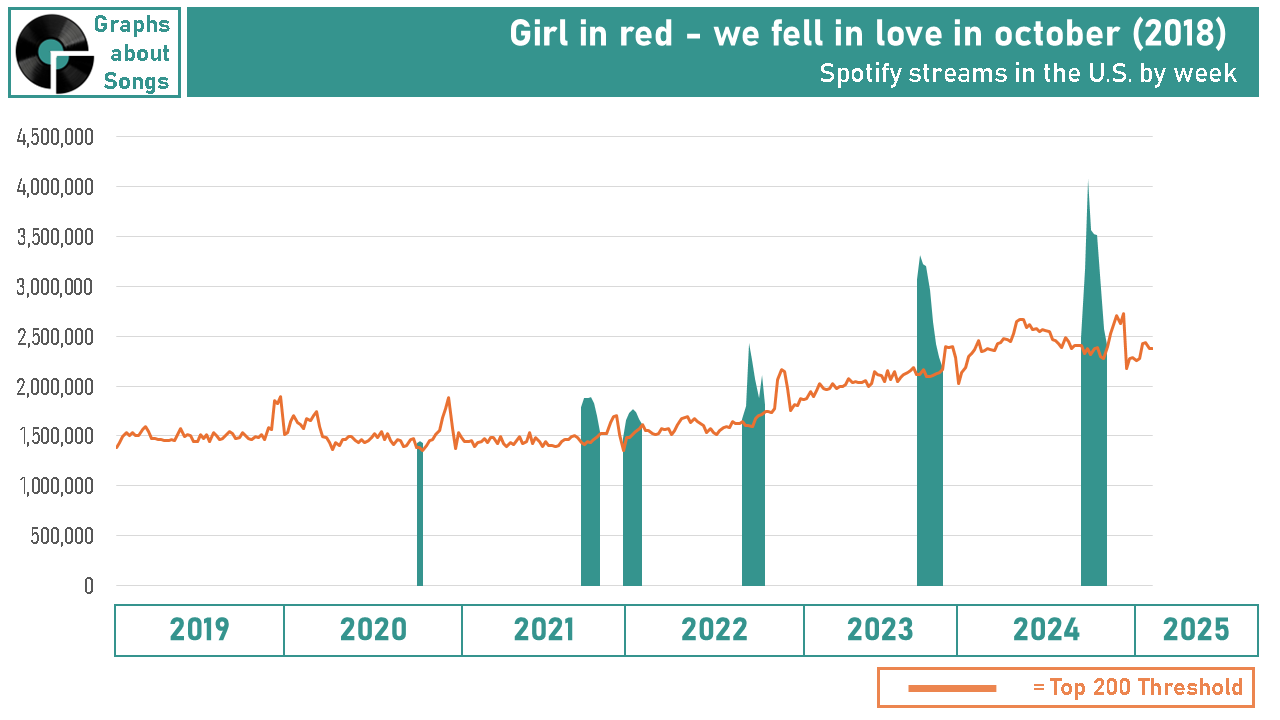Nine Future Gen Z Classics
While Millennials still determine our biggest hits, Generation Z is quietly embracing songs that reflect their life experiences. How will they soon change Pop music?
There’s a group of songs from the 2010s that, week after week, receive as many plays on Spotify as today’s big hits.
Most of them are songs you never hear on the radio.
Collectively, these songs receive more streaming than the biggest Classic Hits of the 60s, 70s, and 80s, the biggest Alternative classics of the 90s, 00s, or 10s, or the biggest Throwbacks of the 00s and 10s.
So how is the most streamed style of older songs also the least well-known style?
Simple: Today’s teens have developed their own tastes based on their own life experiences, technology preferences, and attitudes. So far, they’re not old enough to ultimately control which songs become big hits. Adults in their 20s and 30s still do that. However, that’s about to change.
If you want to understand how popular music is about to change in ways that will take even music industry insiders by surprise, get to know the future classics they’re streaming today on Spotify.
Who exactly is Generation Z?
There are a lot of arbitrary and unfounded definitions for different generations: You’ll often see 1997 as a starting date for Gen Z. However, there’s no evidence at all for this date’s significance.
Instead, I rely on historians Neil Howe and his late partner William Strauss to define when each generation starts and ends. Their seminal work, Generations: The History of America’s Future, not only invented the term Millennial, it also predicted “The Crisis of 2020,” way back in 1991. I dive deep into their work in The Generational Music Theorem. For now, just know…
Adults in their 20s are Millennials. If you’re just old enough to remember the Bush administration and before the great recession, you’re among the last wave of Millennials.
Teenagers in high school and college are Generation Z. If the first President you remember is Obama and have no memory of a time without an economic, political, or public health crisis, you’re the first wave of Generation Z.
So which songs from the past decade are today’s teens and college students playing on Spotify as often as they play today’s hits? I examined the weekly Spotify 200 charts in the U.S. from January 2024 through February 2025 to find out.
Note that the graphs below, which each songs stream count by week, only register a song during weeks it qualified for the Spotify 200 chart. The orange line shows the cutoff for the Spotify 200. Fans undoubtedly were still playing these songs on other weeks, but it ranked #201 or below during weeks with no streams.
Nine Artists and Songs from the 2010s that Gen Z revived in the 2020s:
1) Tyler, The Creator, Kali Uchis - See You Again
Among today’s teens, Tyler, The Creator is as big as Kendrick Lamar and definitely cooler than Drake. He’s a taste maker in alternative Hip Hop, combining musical elements in unconventional ways. He’s also made references to being in same sex relationships in many of his songs.
“See You Again”, originally from 2017, was already big on Spotify for several years when it also blew up on TikTok. in 2023—which increased its Spotify plays almost four-fold.
“See You Again” has been on the Spotify 200 every single week in 2024 and 2025 and somehow is still growing.
2) The Neighbourhood - Sweater Weather
Whether intentionally or accidentally, this alternative song from 2013 became meme shorthand for bisexuality during the past decade. Starting in 2020, the song became heavily used on TikTok, which returned it—seemingly permanently— to the Spotify 200.
“Sweater Weather” is the 7th most streamed song on Spotify overall, with over 3.7 billion plays worldwide. That’s as big as "Sunflower" by Post Malone and Swae Lee
“Sweater Weather’s” appeal isn’t just as a signifier of sexual orientation: It also sees its highest stream counts during Fall months, when one might wear a sweater.
Although its popularity has since waned, The Neighbourhood’s “Daddy Issues” also was popular among Spotify users from 2020 through 2022.
3) Frank Ocean - • Pink + White
Five different Frank Ocean titles routinely appear among Spotify’s most-played songs in the U.S., the biggest of which is 2016’s “Pink + White”. Ocean has done for Alternative R&B what Tyler, The Creator has for Alternative Hip Hop, with idiosyncratic, genre blending style. Ocean has also publicly come out as bisexual and has actively supported gay and transgender rights, particularly in the black community.
He’s also written songs for everyone from Beyonce to Justin Bieber.
“Pink + White”’s Spotify streams surged after his appearance at Coachella in 2022:
Almost three years later, “Pink + White” is still among the most played songs on Spotify every week.
Although not as consistently popular today, “Novacane” also saw a surge in appeal after Ocean’s 2022 Coachella performance.
“Novacane” is once again routinely in the Spotify 200 this year, however.
In 2024, TikTok revived several Frank Ocean tracks, including 2012’s “Thinkin’ About You,” Ivy,” and most recently, “White Ferrari.”
4) TV Girl - · Lovers Rock
They’re an Indie Rock band with a sound some call “nostalgic” that gained a cult following throughout the 2010s. Their 2016 song “Not Allowed” was already reaching the U.S. Spotify 200 periodically in 2021.
However, it was their emergence on—-wait for it—-TikTok that brought back 2014’s "Lovers Rock.” It’s been their most-played song on Spotify this past year.
“Lovers Rock” samples an obscure song from The Shirelles:
Two additional "TV Girl songs are routinely among the Spotify 200 since 2023.
5) Hotel Ugly - Shut up My Moms Calling
Originally dropped in 2020 (and the newest “Classic” on this list), “Shut Up My Mom’s calling” only became popular on Spotify when it blew up on—-let’s hope it’s not your chosen word for the Graphs About Songs’ Drinking Game—-TikTok.
“Shut Up..” has been among Spotify’s 200 biggest songs every week until February 2025.
6) Steve Lacy - Dark Red
Originally recorded on his phone, “Dark Red” was a part of an album literally called “Steve Lacy's Demo.” And yes, it was TikTok that made it viral, but in 2022, a year earlier than many of these songs.
The song also received a boost when Lacy released “Bad Habit” in 2022, which did receive modest airplay on hit music radio.
“Dark Red” only fell out of the Spotify Top 200 this past February.
Like Tyler, the Creator and Frank Ocean, Steve Lacy has publicly shared his bisexuality since 2017.
Lacy’s “C U Girl” also occasionally reached the Spotify 200 during 2024.
7) XXXTENTACION - Revenge
His career was short and his life ended in murder 2018. Like Tyler, The Creator, XXXTentacion blends Hip Hop with other genres not traditionally a part of the genre. Like many of his teenage fans, XXXTentacion struggled with depression, a theme in his songs.
Unlike many of the artists on this list, XXXTentacion didn’t have to wait for chart success. His 2017 album reached number two on the Billboard 200 chart and his 2018 release debuted at number one.
His biggest song on Spotify, “Revenge,” is one he dedicated to a friend after she committed suicide. TikTok brought it back to fans’ attention in 2022.
“Revenge” returned to the U.S. Spotify 200 in March 2024 and stayed there almost every week until 2025.
XXXTentacion’s “Fuck Love” from 2017 was still in the Spotify 200 in 2019, returning in 2024.
8) PARTYNEXTDOOR - Break from Toronto
Drake is responsible for PARTYNEXTDOOR breaking. He was the first artist signed on drake’s label and toured with him in 2013. He originally gained his fan base on SoundCloud and iTunes, downright quaint technologies for today’s teens.
His continued album releases and work with Drake have brought“Break From Toronto” back to the Spotify 200 several times this decade.
PARTYNEXTDOOR’s style adds electronica elements to Hip Hop. In addition to performing, he’s also a respected producer and songwriter, credited on Rihanna's “Work” and DJ Kaled’s “Wild Thoughts.”
2015’s “Dreams” also returned to the Spotify 200 for several weeks at the end of 2024, spurred by new material with Drake.
9) Surf Curse - Disco
Their most played song on Spotify in 2024 was “Disco,” a five-year-old song that went viral as a TikTok dance.
Their biggest revived song this decade, however, is 2013’s “Freaks, a regular on the Spotify 200 chart in 2021 and 2022 thanks to a TikTok trend. “Freaks” also returned for a few weeks in late 2024:
What do these songs teach us about Generation Z?
Forget what you’ve spent two decades learning about Millennials. Today’s teens have no memory of:
The 2000s housing boom.
The internet being new and fun.
Democrats and Republicans being friends.
Instead, their childhood coincided with financial uncertainly, political divisiveness, rampant school shootings, climate fears, and a deadly pandemic.
That environment is making them cautious and insecure.
We Gen X parents know its dangerous out there. We’re as over-protective of our Gen Z kids as our parents were under-protective of us in the 70s.
How has that shaped their music?
They seek calmness and intimacy in their music.
Many of the songs Gen Z loves have a laid back vibe, with comfortingly nostalgic elements hankering to a simper time they never knew. They’re the first generation in living memory whose big hits are getting softer—not louder—than the previous generations. That’s partly technological: Teens don’t blast music on stereos in their rooms anymore. Today, they listen to music privately, on their phones with Bluetooth earbuds and headphones. It’s also psychological: With so much stress in their outer world, Generation Z uses music to create an oasis in their inner world.
They appreciate lyrics that are sensitive to their feelings.
Today’s teens are keenly aware of the dangers of ignoring one’s mental health. Songs that are real about depression and anxiety are becoming popular in ways unimaginable to older generations.
They’re inclusive, both lyrically and musically.
You undoubtedly noticed that many of these Future Gen Z Classics are from artists who are and appeal to folks who are queer. Considering 28% of adults ages 18-25 identify as LGBTQ+, it’s not surprising they’re a major driver of cutting-edge music trends. While Millennials are team oriented, Generation Z wants to make sure everyone has a place on that team.
These Future Gen Z Classics are also musically inclusive, blending different styles and eras of music in ways we Xers could never fathom in the 1990s.
They only know Rock as Dad’s music
It’s also important to remember that Hip Hop is now the dominant genre of youth culture. It has been since 2003. While today’s teens still might call you a rock star, they have no living memory of Rock-oriented songs being contemporary hits. Just as those nerdy Xers helped popularize Alternative Rock, cutting edge teens today are championing Alternative Hip Hop.
The Pending Evolution of Hit Music
Within the next two years, we’ll reach a tipping point where Generation Z has more influence over which songs become big hits than do Millennials. Historically, that tipping point happens when the oldest members of a new generation turn 21. That’s happening sometime between next week and early 2027.
Like Crunk in 2003, New Wave in 1982, or The British Invasion in 1964, we will soon experience a seemingly sudden evolution in music tastes that catch even music industry insiders by surprise. We can expect tomorrow’s hits to sound more intimate, blend styles unconventionally, be more inclusive lyrically, and discuss fears more honestly than anything we could have imagined a decade ago.
The big question is, will radio be a part of the evolution?
Other Songs form the 2010s that are still huge in the 2020s
In addition to the nine artists and 20 songs spotlighted above, here are five additional songs from the 2010s with ubiquitous presence on Spotify this decade.
J. Cole - No Role Modelz
Miguel’s “Sure Thing,” wasn’t just a throwback hit on Spotify, radio was playing it as a current hit starting in late 2022. It’s been a regular in the Spotify 200 ever since.
Kendrick Lamar’s HUMBLE” never really went away. It was still among Spotify’s most played 200 songs in 2019. It returned there in 2024 when “Not Like Us” was huge and saw a massive spike in streams after Lamar’s 2025 halftime performance.
Norwegian singer girl in red is an icon among Gen Z’s LGBTQ+ community, so much so that “do you like girl in red” is shorthand among some teens for, “are you a lesbian?” Her songs’ earnest discussion of mental health challenges have also endeared her to today’s teens. However, “we fell in love in october,” is primarily popular in—-wanna guess?—-October.
There’s one more post in my series exploring the most-played Classics on Spotify during 2024-2025… but it won’t be about those Classics.
Subscribe below to get that post in your inbox as soon as I release it. (Choose “none” for the FREE option):
Date source for this post:
Spotify Charts (weeks of 1/3/2019 through 2/28/2025 for the USA): https://charts.spotify.com/charts/overview/us







































